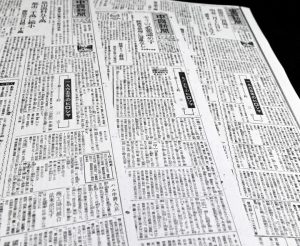Striving to fill voids in Hiroshima, Chugoku Shimbun and the press code — Surveillance of articles with A-bombing content, Part 7: Poet Sankichi Toge’s award-winning essay
Sep. 28, 2023
Inconsistent censorship standards might have resulted from response to “labor union” description
One year had passed since Hiroshima was destroyed by the single atomic bomb dropped by the U.S. military on the city. The front page of the August 1, 1946, edition of the Chugoku Shimbun newspaper announced award-winning essays for the contest it had organized called “Creation of Utopian Hiroshima.” The contest had been held by the newspaper to commemorate the first anniversary of the atomic bombing.
Among 171 essay submissions for the contest, the top prize was awarded to Sankichi Toge for his work titled “Hiroshima in 1965.” Mr. Toge later made his name as a poet by releasing Poems of the Atomic Bomb, a collection of poetry known for the phrasing “Give back my father, Give back my mother.”
Mr. Toge’s essay was divided into three parts and carried in the newspaper from August 2 through August 4. He criticized the atomic bombing even as the U.S. press code restricted freedom of speech in Japan. How did the censorship process handle his essay in the Chugoku Shimbun? When the essay and related articles were investigated, censorship of the information was found to have been inconsistent.
To begin, the article calling for the public to submit essays to the contest, published on June 27, 1946, had been censored. However, the article announcing the award-winning essays had not been censored. It is not known whether the first section of Mr. Toge’s essay carried in the newspaper had been censored, because no copies of the censored newspaper are archived at the University of Maryland’s Gordon W. Prange Collection in the United States. The second part of his essay had not been censored, but the third and final part had been.
Essay looked at restoration of city
Of the essay series, why had the third part been censored?
Mr. Toge imagined in the essay what Hiroshima would be like 20 years after the atomic bombing, describing the ideal city post recovery.
The protagonist in the essay visits Hiroshima on “a bullet train” from Osaka to attend a ceremony on August 6. The essay’s first part describes his view of a city with a subway running through it, as well as major theaters and government offices. In the second part, the essay details the city’s active agriculture and livestock industries. He wrote that the islands in the Seto Inland Sea were covered with world-class fruit orchards and described how dairy products were being shipped to domestic and international markets.
A state-run livestock processing factory makes an appearance in the essay’s third part. Almost equal numbers of men and women were at work in the factory, which was managed by a labor union, with a woman elected as factory manager.
The essay then delves into August 6. The memorial ceremony begins at 8:15 a.m., with 10,000 people in attendance. At the ceremony, the mayor delivers a speech. “Today, when vividly recalling the color of flames engulfing the city and the groans and screams of the people, I am once again viscerally angered at the military cliques and industrial conglomerates of the nemesis of humanity itself” (as indicated in the original text), he proclaimed.
Description of mayor’s anger might have been cause of censorship
The press code also turned a stern eye on the labor movement. The third part of the essay was censored because of what might have been considered the problematic description of labor unions. Or the censors might have been concerned with the anger and resentment expressed in the mayor’s speech. Lacking supporting documents, however, such theories remain mere speculation.
At one time, people insisted that the actual writer of the essay was Kazuo Toge, Mr. Toge’s older brother, who had also submitted his essay to the contest. Later, however, a rough draft of the essay written by Mr. Toge himself was discovered. Masahiko Ikeda, secretary general of the civic organization the Association for Preservation of Literary Materials of Hiroshima, shared his view of the situation, suggesting that, “The essay can probably be considered a collaboration between Mr. Toge and his older brother.”
Mr. Toge was 29 years old at the time. He was busy working on cultural activities, including serving as chair of the Hiroshima Youth Cultural Federation. In the pre-war period, his brother Kazuo had been expelled from the Third High School (present-day Kyoto University) under Japan’s former educational system for his involvement in anti-establishment movements, and with that he threw himself into the labor movement. The appearance of the labor union in Mr. Toge’s essay might have been his brother Kazuo’s dream and wish.
(Originally published on September 28, 2023)








